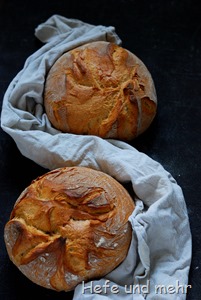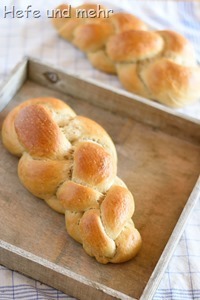 It was such a stormy Sunday! The sun was glimpsing through the clouds now and then, but the whole time trees were bending under the power of wind. It was the right weekend to stay home and bake bread.
It was such a stormy Sunday! The sun was glimpsing through the clouds now and then, but the whole time trees were bending under the power of wind. It was the right weekend to stay home and bake bread.
And so I bake a delicious braid. But as we have a tiny bit of stormy days in our life, too, with a lot of appointments eating up time, there was no time for a preferment. And as I wasn’t baking in my own kitchen, I had no kitchen machine to take up kneading either. These were the facts I had to build my recipe around.
At the end, I opted for buttermilk and a long, cold proof to enhance flavour. And I decided to bake the Braid in Swiss Style, which means: no sugar in the dough. Without sugar, it is much easier to knead the dough to middle gluten development as sugar tends to inhibit gluten development.
My plan worked as well as I could hope for, and the next day I started my morning with some freshly baked bread. Is there a better start in a chaotic week?


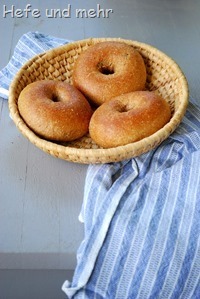
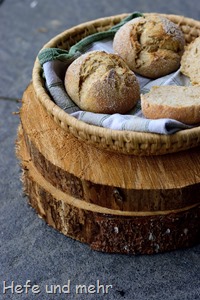 Sometimes it is just time to use leftovers. Like last friday, when I looked around in the kitchen: there was some leftover fine rye meal from the blackbread, a small bowl with mashed potatoes and in the fridge I found a lonely egg yolk. And so I combined everything and kneaded a dough for the next day. As I prefer freshly baked rolls for breakfast, the dough rose overnight in the fridge.
Sometimes it is just time to use leftovers. Like last friday, when I looked around in the kitchen: there was some leftover fine rye meal from the blackbread, a small bowl with mashed potatoes and in the fridge I found a lonely egg yolk. And so I combined everything and kneaded a dough for the next day. As I prefer freshly baked rolls for breakfast, the dough rose overnight in the fridge. Some weeks ago a reader asked me if I had an idea for a spelt variant of the
Some weeks ago a reader asked me if I had an idea for a spelt variant of the  Kieler Semmeln are rolls which stem – as their name suggested – from Kiel. They are a special roll as they are rubbed in a mixture of butter and salt, which gives their surface a rough look and adds a nice buttery and sligthly salty flavour. There are different recipes around for this kind of rolls, some of the containing lard or cinnamon as well. Cinnamon seems to me a bit to adventurous for a first trial, but I keep this variant in the back of my head for a second version.
Kieler Semmeln are rolls which stem – as their name suggested – from Kiel. They are a special roll as they are rubbed in a mixture of butter and salt, which gives their surface a rough look and adds a nice buttery and sligthly salty flavour. There are different recipes around for this kind of rolls, some of the containing lard or cinnamon as well. Cinnamon seems to me a bit to adventurous for a first trial, but I keep this variant in the back of my head for a second version. Last year I saw a
Last year I saw a  There are three different ways to soak seeds or flour: You can either cook them, or soak them in hot water or in cold water. For this bread I decided to soak the seeds in cold water. They do not absorb not as much water as when hot water is used, and this results in seeds which have still some bite. As the seeds have to soak overnight some salt is added to prevent them from fermenting.
There are three different ways to soak seeds or flour: You can either cook them, or soak them in hot water or in cold water. For this bread I decided to soak the seeds in cold water. They do not absorb not as much water as when hot water is used, and this results in seeds which have still some bite. As the seeds have to soak overnight some salt is added to prevent them from fermenting.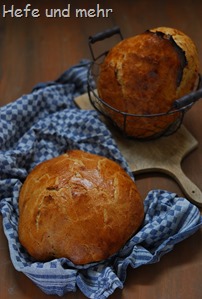 “Eingenetztes Brot” would be Net-Bread if translated literally. But the origin from the word “eingenetzt” does not stem from the German “Netz” (net) but from “Nass”, which means “Wet”. And making the bread is wet indeed. The sticky dough is easiest to handle when hands and tools are really wet. When the bread is placed in the oven its surface is wet as well. This helps to create the shiny crust which is characteristic for this bread. To get the soft dough in the oven without accident, a so called “Schapf”, a kind of ladle, is used traditionally. Even in my rather big kitchen collection, there is no “Schapf” and so I used a small salad bowl instead. And this worked fine!
“Eingenetztes Brot” would be Net-Bread if translated literally. But the origin from the word “eingenetzt” does not stem from the German “Netz” (net) but from “Nass”, which means “Wet”. And making the bread is wet indeed. The sticky dough is easiest to handle when hands and tools are really wet. When the bread is placed in the oven its surface is wet as well. This helps to create the shiny crust which is characteristic for this bread. To get the soft dough in the oven without accident, a so called “Schapf”, a kind of ladle, is used traditionally. Even in my rather big kitchen collection, there is no “Schapf” and so I used a small salad bowl instead. And this worked fine!